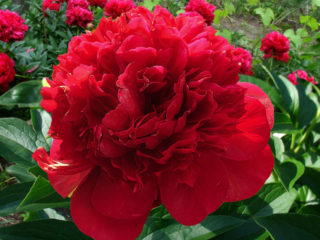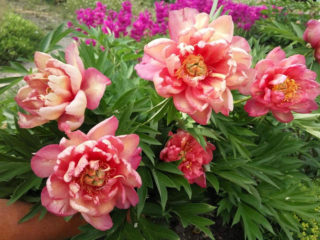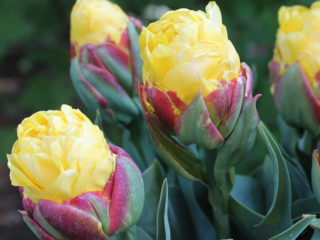Content
Even beginners in gardening can care for and plant a window sill. The plant can be propagated in different ways; it is grown in open ground. Care should be comprehensive, but all its stages are standard.
Description
Pokonnik is a perennial of the Asteraceae (Asteraceae) family. It is widespread on several continents - Eurasia, America, Africa (tropics). There are about 130 species of this plant, not counting more than 200 species of uncertain status. Main characteristics:
- height depending on the type 0.3-2 m;
- erect stem, branched in some species;
- leaves petiolate or sessile, opposite arrangement, whorled in some species;
- the shape of the leaves is often ovoid, lance-lanceolate or linear;
- the foliage is dark green or lilac, some varieties have purple veins;
- the edges of the leaves are entire or serrated, the surface can be smooth, rough, or pubescent;
- the flowers are small, collected in inflorescences-baskets with a diameter of 25 cm;
- strong aroma;
- the shape of the flowers is tubular, the color is white, pinkish, mauve, purple, bluish-lilac;
- flowering occurs at the end of summer and beginning of autumn;
- fruit – crested achene;
- decorative effect lasts up to 10 years.

Poskonnik is poisonous, but is used in folk medicine and homeopathy
When to plant saplings
Planting times depend on the chosen method. Most people prefer to grow this plant from seeds. After preparation, they are sown in early March. Seedlings appear in 2-3 weeks. Seedlings are transferred to open ground no earlier than mid-March.
The sill is also planted with rhizomes. This should be done in April, before shoots appear. Otherwise, there is a risk of damaging them, which can destroy the plant.
Growing from seeds
Obtaining sapling seedlings from seeds at home requires some preparation. The material is small, so for convenience it is mixed with sand. In order for seeds to germinate faster, cold stratification is needed:
- Moisten the sand.
- Mix it with seeds.
- Place this combination in a glass container.
- Place the mixture in the refrigerator on the bottom shelf (compartment for vegetables and fruits).
Stratification takes a month. Then proceed like this:
- Prepare the soil. It is better to use a ready-made mixture for seedlings.
- Fill boxes or other containers for seedlings with soil.
- Disinfect the seeds. To do this, soak them for a day in a solution of potassium permanganate.
- Sow the seeds.Deepen to a maximum of 0.5 cm, compact the soil, and water generously.
- Organize a shelter - glass or film.
- Place the boxes in a warm place.
- After sowing the sill, caring for the seedlings consists of regularly removing condensation, daily ventilation, and spraying the soil - it should not dry out.
- After the sprouts appear, remove the cover.
- When 3-4 true leaves appear, plant the sprouts in individual containers. It is better to use peat pots.
Seedlings are moved into open ground only after hardening. It is carried out for 1.5-2 weeks. Place the seedlings outside; drafts and precipitation are not allowed. The duration of hardening is increased gradually.

When planting seeds, you need to wait 2-3 years for flowering
How to grow saplings in the garden
Growing saplings is not difficult. The plant is easy to care for and can be used in different ways in landscape design.
Where does sapling grow well?
To successfully grow saplings, the planting site must meet a number of conditions:
- sunny place, short shading is allowed during the day;
- soil acidity is neutral;
- moist and fairly fertile soil with good drainage;
- Clay and sandy loam soil is not suitable - the plant may wither and die in such conditions.
If the garden has sandy soil, then be sure to add compost - 3-5 kg per 1 m². Before planting, the area is dug up and then leveled with a rake. Holes are made for plants; they can be drained with river pebbles or expanded clay.
Watering and weather
The sapling is a moisture-loving plant.It can tolerate short-term drought, but the rest of the time it requires regular watering.
There is a special need for moisture during the period of active growth - spring and summer. At the end of flowering, watering should be reduced.
Overmoistening and stagnation of moisture should not be allowed. Because of this, the root system will rot and the plant will die.
Top dressing
The agricultural technology of the window sill necessarily includes timely application of fertilizers. This is necessary for good growth and abundant flowering.
Fertilizers are applied at least 3 times per season during specific periods:
- spring;
- June;
- bud formation.
The plant responds well to complex mineral fertilizers - Kemira, Zdraven, nitroammofoska. For the second feeding, you can use bird droppings or mullein and make a weakly concentrated solution.
Features of seasonal care
In addition to watering and fertilizing, care involves the following activities:
- loosening - carried out after watering and heavy rains;
- weeding is combined with loosening;
- mulching with organic matter, this measure reduces the amount of watering and weeding.
Flowering period of the sapling
Most varieties begin flowering in August. At this time, we must remember about regular watering, on which the abundance and splendor of flowers depends.
If proper care is provided, young shoots will appear regularly. For bright and abundant flowering, thin and weak arrows must be cut out.
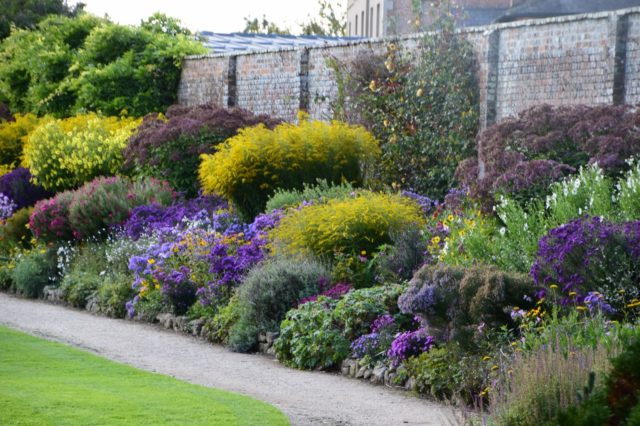
You can do without tying if you plant a window sill along a fence or wall
How does the sapling reproduce?
The plant can be propagated in a variety of ways, including self-sowing. It is organized by leaving faded inflorescences. For the winter they need to be covered with a small layer of soil.
Dividing the bush
You can divide the bush when it is at least 5 years old. Reproduction in this way is planned for spring or autumn. It is recommended to do this at the beginning of growth after winter or in the last ten days of summer. The algorithm is simple:
- Divide the root system of the bush with a shovel or knife.
- Each part must have at least 3 buds.
- Plant the plants in pre-prepared holes.
Young shoots
With this method of reproduction, restoration buds are used. The algorithm is like this:
- In the spring, wait until the shoots reach a height of 5 cm and cut them off with part of the rhizome.
- Plant the buds. You can use separate containers or one common one. In the second case, maintain an interval of 7 cm.
- Keep plantings shaded and water moderately.
The shoots are transferred to open ground after rooting. This takes about a month.
Reproduction of saplings by cuttings
The plant is propagated in this way at the end of June. The cuttings should be green. Must have at least 3 kidneys. The algorithm is as follows:
- Cut cuttings 10-15 cm long.
- Plant them in a mixture of sand and peat.
- Make a film cover.
Transplantation into open ground is carried out after rooting. It takes about a month.
Trimming
Due to the annual death of obsolete branches, the window sill does not require pruning during the growing season. It is carried out only as part of pre-winter preparation. The exception is the removal of inflorescences as they wilt to prevent self-seeding.
Winter hardiness of the window sill
Frost resistance is high. Only young plants need to be covered, as well as those planted in regions with harsh winters.
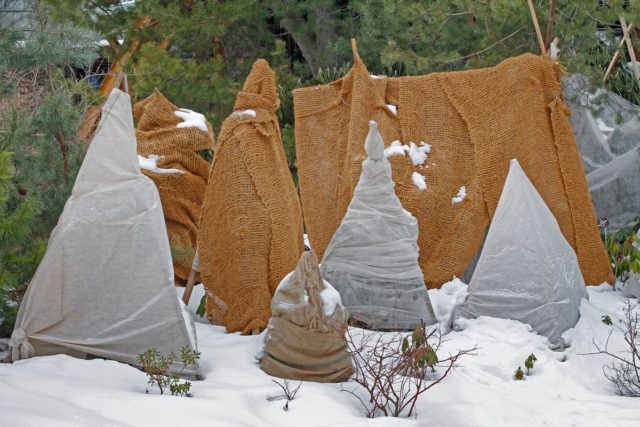
Spruce branches, agrofibre, and other non-woven materials can be used as cover for the window sill.
Preparing for winter
In preparation for winter, caring for the window sill in the fall involves reducing the intensity of watering and pruning. The latter measure is optional and can be carried out in early spring.
The window sill must be cut down to the ground. This is done in the fall, when flowering is completely over. There should be stumps up to 10-15 cm long. Pruning is done with a sharp knife.
Diseases and pests
One of the advantages of saplings is resistance to diseases and pests. The main enemy of the plant is miner flies, so called for the mines they leave inside it. These passages are covered by a thin skin, so chemical control methods are ineffective. Affected leaves should be removed. When the pest spreads widely, Aktar and Vermitek are used. These drugs have a contact-intestinal effect.

Miners not only damage plant leaves, but are also carriers of viruses.
Regional features
When growing saplings, it is necessary to take into account the characteristics of a particular variety and region. For example, the process for Siberia is somewhat different from planting in the Moscow region.
Planting and caring for window sills in Siberia
This plant can be successfully grown in Siberia, but it should be covered for the winter. Purple sapling has good frost resistance. This is what gardeners love most.
Various varieties of spotted sapling also tolerate cold well. Album is especially popular among them.
Wrinkled window sapling is not recommended for Siberia. It is characterized by late flowering, which does not occur at all in cold regions.
Growing in the Moscow region
Planting and caring for window sills in the Moscow region is carried out according to general rules. The plant survives the winter well and does not require insulation. The exception is wrinkled sapling, especially the Chocolate variety. It needs to be covered for the winter.
Photos in landscape design
The window sill can be used in different ways in the landscape. It is effective to plant it along fences and various buildings.
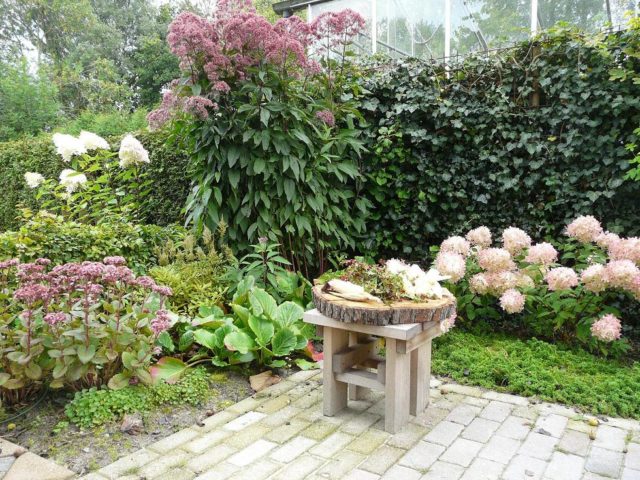
The window sill serves as a good camouflage for unsightly buildings and shelter from prying eyes
In mixed flower beds, tall varieties of window sills should be placed in the center. When creating multi-level plantings, it should be planted together with other tall plants in the very last row.
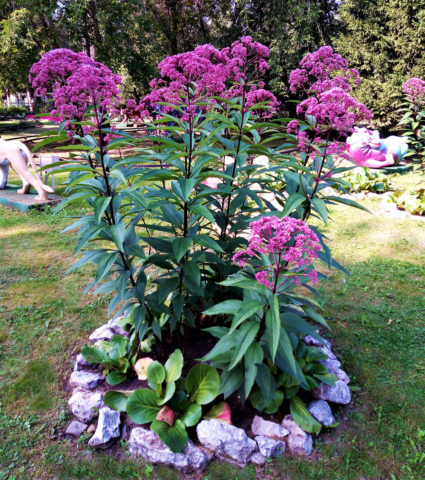
The plant can be effectively planted even without neighbors, creating large accents on the site
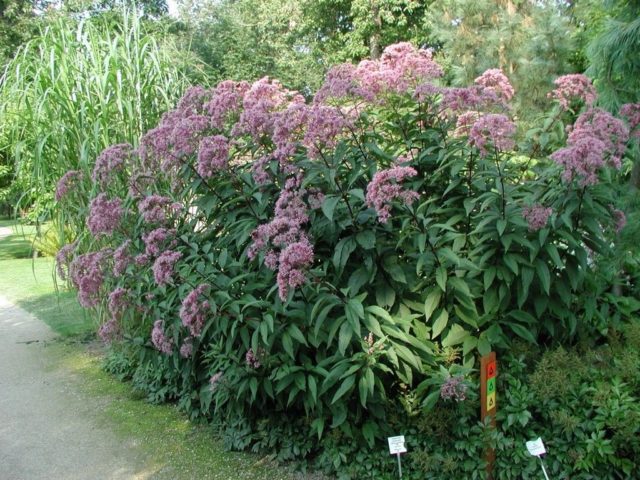
Sill trees are good to plant along paths for beauty or zoning
Some flowers can be used for cutting. They retain freshness for a long time and are suitable for making ikebana.

In nature, the window sill prefers places near bodies of water; this can be used in landscape design
What does the sill go with?
The sapling can be combined with different plants. If you need harmony in color, then you should choose Japanese anemone, astilbe, knotweed, delphinium, loosestrife, black cohosh (cohosh), New England asters, and purple coneflower.
To create contrast, you can choose buzulnik, helenium, daylily, rudbeckia, and solidago.
In terms of flowering time, the sapling goes well with large ornamental grasses.
Conclusion
Caring for and planting a window sill will not take much time and effort. The plant is unpretentious and does not require special pre-winter preparation. It can be effectively used in landscape design in group and single plantings, for camouflage, fencing, and zoning.


